Installing an air conditioner in the corridor: choosing the optimal location and nuances of installing the air conditioner
Nowadays it is impossible to imagine life without air conditioning.Providing a comfortable room temperature during the hot season, air cooling systems have become firmly established in human everyday life. They are installed in factories, offices, houses and apartments. The choice of installation location determines not only the most efficient operation of the device, but also the health of people inside the room.
The number of installed air conditioners usually depends on the number of rooms in the apartment, however, a limited budget and the desire to reduce the amount of electricity consumed force us to come up with ways to optimize costs. One of them is to install an air conditioner in the hallway of the apartment. But how to do this correctly and what nuances to consider when choosing a place for installation?
It is these questions that we will discuss in our article, considering the nuances of choosing the optimal location in the corridor to install an air conditioner. Let's look at the pros and cons of this solution and give useful recommendations.
The content of the article:
Why install an air conditioner in the hallway?
In summer, as temperatures rise, the demand for air conditioners increases sharply. In rooms where air conditioners are installed and operating, a fairly comfortable microclimate is formed.
But owners do not always have the opportunity to install climate control equipment in all rooms - they need to reduce energy consumption or there is no financial opportunity. But I want to create a comfortable microclimate throughout the entire apartment.
It is the solution to the issue of savings and the ability to provide cool air to all living areas of the apartment that pushes the owners to look for alternative solutions, including:
- installation of one powerful air conditioner in one of the rooms;
- installation of one air conditioner in the hallway.
It is worth noting that installing a household air conditioner in the hallway is considered more acceptable - this is the passage part of the apartment, in which no one lingers for a long time.
If you choose one of the rooms as a location, then to cool the entire apartment with one device, you will need to set a lower temperature, which can lead to colds and other diseases for those who will be in this room.
By installing an air conditioner in the hallway, it is indeed possible to cool the entire apartment, but this will only happen if the power of the equipment is correctly selected and its correct location in the hallway.
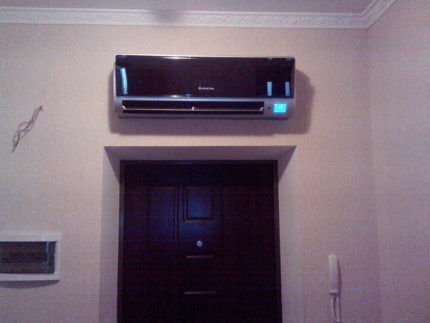
When choosing one air conditioner for the entire apartment, it is necessary to take into account an important parameter - the cooling capacity of the device (cooling power). It is indicated on all equipment in kW or special units of measurement - BTU (British Thermal Unit).
For selecting the required power it is necessary to calculate the area of the apartment. So, for 10 square meters an air conditioner with a power of 1 kW (3412 BTU) is suitable.
It is worth noting that to cool all the rooms in the apartment you will need a fairly powerful device, which, in terms of its geometric parameters, will have impressive dimensions.
Pros and cons of such placement of equipment
Now let's talk in detail about the pros and cons of installing an air conditioner in the hallway. As already noted, such a decision comes from the desire ensure the same comfortable temperature throughout the entire apartment one device.
The advantages of this solution also include:
- annual Maintenance only one air conditioner is required;
- centralized cooling system;
- lack of directed cold air in living rooms, which reduces the risk of disease;
- lack of temperature difference in individual rooms of the apartment, which also affects human health.
This placement of the air conditioner also allows you to cool the kitchen, which has a beneficial effect on the person preparing the food.
It is important to take into account that if there is poor air exchange (closed doors or open windows in one of the rooms), the air temperature will equalize much longer, remaining in the corridor a couple of degrees lower than in that part of the apartment where air flow is difficult.
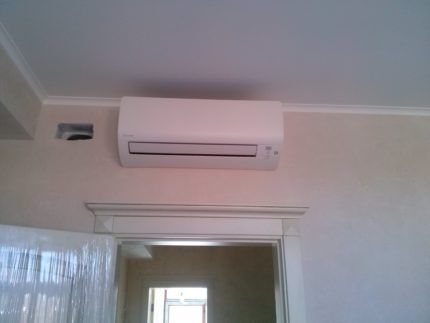
Disadvantages of this solution:
- If you choose the wrong location for the indoor unit, there may be a failure in uniform cooling of all rooms - the temperature in other rooms may differ by 5-6 degrees;
- impressive dimensions of the indoor unit - if you use a powerful system;
- complex work on installation and laying communications - since the distance between the indoor and outdoor units will be quite impressive, additional technical implementation will be required;
- high price good air conditioner, as well as considerable installation costs.
When installing the indoor air conditioner unit in the hallway and connecting it, the work may affect several rooms of the apartment.
It is worth noting that it is not necessary to purchase air conditioners with cooling capacity for the entire area of the apartment. When purchasing standard equipment designed to work in one large room, the cooling function will also be performed (slightly longer than with a more powerful device); there is simply a greater likelihood of a quick breakdown of the climate control equipment.
Recommendations for choosing a suitable location
When installing an air conditioner in the hallway of the entire apartment, the choice of location determines the uniformity of air cooling in all parts of the apartment, as well as the correct operation of the device.
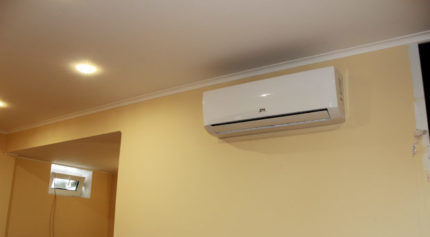
Fundamental rules for choosing a location in the corridor for installation of climate control equipment:
- The exhaust air flow from the indoor unit should not rest against a nearby wall. It is advisable to install the unit in such a way that the flow of cold air can be directed as much as possible to other rooms of the apartment. The minimum distance to the opposite wall is 1 meter.
- Maintaining the distance between the ceiling and the top of the indoor unit. It should be at least 10-15 cm to ensure unhindered air flow.
- Do not install the outdoor unit next to furniture (cabinets), it is advisable to maintain a distance of at least 1.5 meters.
- Choosing the right wall for installing the indoor unit — the choice should be made taking into account the most functional arrangement of communications for connection to the external unit.
- Distance from the wall to the side walls of the block - when installing the indoor unit in the corner of the corridor, take into account the location of the side walls of the unit relative to the walls of the apartment - at least 20 cm.
- Installation of the external unit is carried out only on the wall of the building — cannot be installed on a balcony frame due to the large weight of the block and quite powerful vibration.
When deciding to install a household air conditioner in the hallway, it is worth assessing its area.
Thus, the relatively small size of the room (less than 5-6 square meters) and longitudinal corridors will not allow the air conditioner to function normally. The effect of beating cold air will damage the temperature sensor.
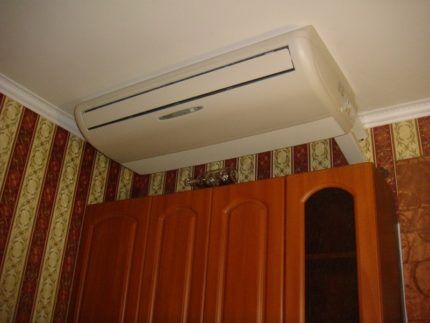
Also, in the absence of air circulation (closed interior doors), rapid cooling of a small corridor space will automatically turn off the compressor (thanks to the temperature sensor located on the indoor unit). Thus, the cooling of the space will stop.
The nuances of installing an air conditioner
Installing a household air conditioner in a hallway is a rather complex technical undertaking that can lead to some changes in the interior of the hallway. Experts advise combining this operation with renovation of the corridor.
The main nuances that arise when installing an air conditioner:
- Mandatory installation of a separate power line.
- Determining the location of condensate discharge.
- Selecting the location for the air conditioner communication route.
With the first point, everything is quite simple in the sense that running the power line into the hallway from the distribution point on the staircase will not require wall cutting. It is enough to bring the cable inside the apartment and run it in the corner between the wall and the ceiling.
Selecting a location laying communications provides two solution options: through the apartment or through the entrance. The second option is the most acceptable - when laying out the communication route connecting the external and internal air conditioner units, only one hole will need to be made through the corridor in the apartment. As a rule, it is placed above the front door. If necessary, you can run a power cable through it.
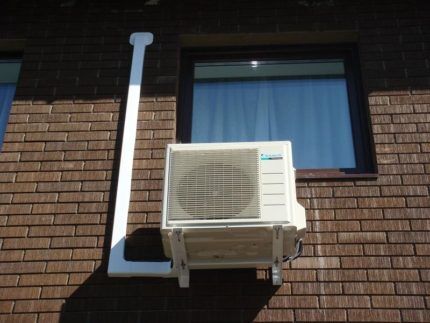
The disadvantage of such a withdrawal of communications is that the entrance is the common property of the residents of the house. In the event of a conflict with neighbors regarding such communications, they can file a complaint with the management company and it will oblige them to carry out dismantling.
Carrying out the route inside the apartment will most likely affect several walls. There may be problems making holes. Also, the installed communication system can disrupt the interior design.
We talked more about installing and connecting an air conditioner in this article: How to install and connect an air conditioner: detailed instructions and error analysis.
Determining the location of the condensate outlet is also considered an important point that should be taken into account and provided for at the stage of choosing the location for installing the indoor unit of the air conditioner.
There are three options for organizing the drainage system:
- outside the house;
- indoors;
- into the sewer.
Moving outside the apartment is considered the most common option. Just keep in mind that kinks must be avoided throughout the entire drainage system and a slope of 3 mm must be maintained for each meter of drainage. In this option, the output is combined with communications between the air conditioner units and is located in the entrance, hiding them with a special box made of metal or plastic.
Bringing the drainage system indoors is considered the simplest and most impractical way. The condensate is drained into a special container, which is installed in the corridor. There is a need to constantly monitor the filling of the container.
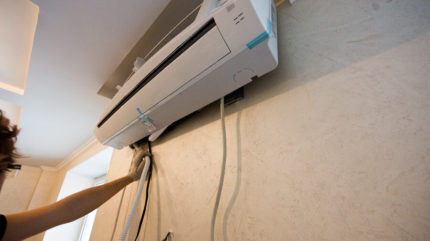
The third option, with condensate being discharged into the sewer system, is used when finishing or major renovation of an apartment at the “rough” stage of finishing work. In this case, the removal of condensate must be carried out under the condition of the presence of a special “dry” siphon when connecting the drainage to the sewerage system. Otherwise, an unpleasant odor may enter the room from the sewer.
It is worth noting that to remove condensate in a drainage system longer than 6 meters, you will need to install an additional, more powerful drainage pump. The disadvantage of this installation is the difference between the service life of the air conditioner and the pump.The pump has a significantly shorter lifespan, so you will have to deal with replacing this element in the future.
We recommend that you familiarize yourself with the rules for setting up the system in more detail. condensate drain.
Conclusions and useful video on the topic
The procedure for installing an air conditioner in the corridor and laying communications are shown in this video:
Another option for placing communications when installing an air conditioner in the corridor is presented in this video:
Installing one air conditioner for the entire apartment is universal for homes with several rooms. Installation in the hallway eliminates the need to purchase air conditioners for each room separately and ensures the same temperature throughout the entire area of the apartment.
However, in order to realize the most efficient operation of the air conditioner with this installation solution, it is worth following the rules for the location of blocks and laying communications described in the article. In economic terms, installation work will cost slightly more due to the length of communications.
If after reading the article you still have questions, you can ask our specialists in the special form below. And here you can share your own experience, add unique photos of your air conditioner installed in the hallway.




Hello! Please tell us the name of the tube through which the refrigerant flows and how much a meter of such a tube costs. And also what is the name of the tube for draining condensate into the sewer?